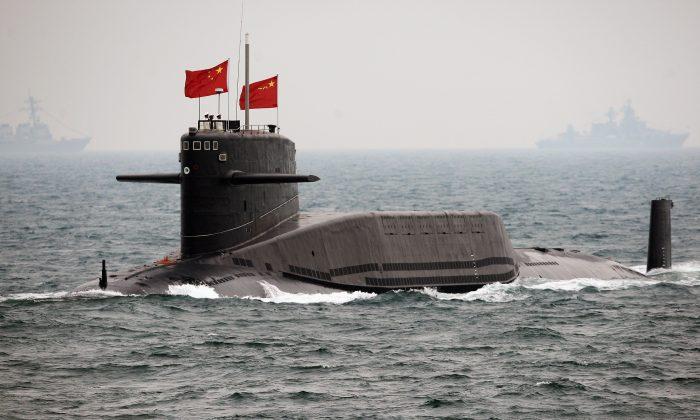Nuclear submarines have been a favorite tool of the Chinese regime’s state-run media recently when trumpeting China’s military strength or threatening the West. Yet, despite the noise China makes about its nuclear submarines, they’re not all they’re cracked up to be.
The U.S. Navy’s top admiral, Jonathan Greenert, was asked about a recent article in China’s state-run Global Times, which claimed China’s submarines could kill 5 million to 12 million Americans with nuclear missiles. Greenert pointed out several key flaws in China’s submarines.
“For a submarine-launched ballistic missile to be effective it has to be accurate, and you have to be stealthy, and survivable and I’ll leave it at that,” Greenert said, during the Nov. 16 Reagan National Defense Forum, The Washington Free Beacon reported.
The Global Times report included a map of the United States complete with targets for nuclear attacks on major cities including Seattle, San Francisco, and Los Angeles. The report followed a segment from China’s state-run CCTV News Network in late October that showed off China’s submarine fleet, in light of China’s territorial disputes in the South China Sea and East China Sea.
Stealth
Yet, Greenert’s comments are well grounded. China’s nuclear submarines have several technical flaws, limits caused by geography, and the deployment of its next-generation fleet has faced several setbacks. This is in addition to the fact that the United States has complex systems capable of monitoring submarines much more advanced than what China can produce.
China’s main nuclear-powered ballistic missile (SSBN) submarine is the Jin-class (Type 094). Three of them are currently operational, and China may have five more in service over the next decade, according to the Pentagon’s 2013 annual report, “Military and Security Developments Involving the People’s Republic of China.”
Despite being China’s most advanced submarines, the Jin-class subs are louder than Soviet submarines from 30 years ago, according to an August 2009 report from U.S. Navy’s Office of Naval Intelligence.
Anti-submarine warfare is based heavily on a nation’s ability to detect and track submarines. The main system the United States uses to track submarines is the Sound Surveillance System (SOSUS), which is part of the Integrated Undersea Surveillance System (IUSS).
SOSUS consists of a large network of undersea sensors installed at choke points in the ocean. It allows the United States to detect submarines and track them based on their noise signatures. It was used during the Cold War to track Soviet SSBNs.
Stealth is one of the key benefits of a submarine force, and controlling noise level is key for achieving stealth. Reducing the level of noise is among the key reasons why submarines are moving from diesel power to nuclear power, and why modern fleets have other advanced technologies for noise dampening.
The majority of China’s submarine fleet is still diesel powered, most of the submarines were purchased from Russia in the 1990s and 2000s, according to the Pentagon report. It is estimated to have 49 diesel submarines and 5 nuclear submarines.
Range
The other problem with the Jin-class submarines is attack range—and this is affected both by technology and geography.
The Jin-class submarines will eventually be armed with China’s JL-2 submarine launched ballistic missile, according to the Pentagon report. The nuclear missiles have an estimated range of 4,600 miles, and are expected to reach operational capability this year.
If a Chinese Jin-class submarine were to target Seattle, it would have to sail deep into Japanese waters, according to a report by Hans Kristensen, director of the Nuclear Information Project at the Federation of American Scientists.
The report states, “Due to the apparent noise level of Chinese missile submarines and the extensive anti-submarine capabilities of the United States that would indeed be risky sailing in a war.”
The other option for the Chinese nuclear submarines would be to fire their missiles over Russia. The report notes, “All China’s ICBMs [inter-continental ballistic missiles] launched at the United States from their current deployment areas would overfly Russia.”
China’s nuclear submarines are confined to a small area around China, and the range of its nuclear missiles is limited. According to the report, if they were to even target Hawaii, the submarines would need to enter the Sea of Japan or the Philippine Sea.
It does state, however, that China’s nuclear-armed subs pose a threat to U.S. territories outside the continental United States, including Alaska and Guam. They are also a threat to U.S. warships in the region.
Keeping Chinese nuclear-submarines out of range from the continental United States relies on keeping them within China’s waters.
China is also developing its next-generation SSBN, the Type-096, which according to a forthcoming report from the U.S.–China Economic and Security Review Commission is expected to “improve the range, mobility, stealth, and lethality” of China’s nuclear subs, Defense News reported.






Friends Read Free